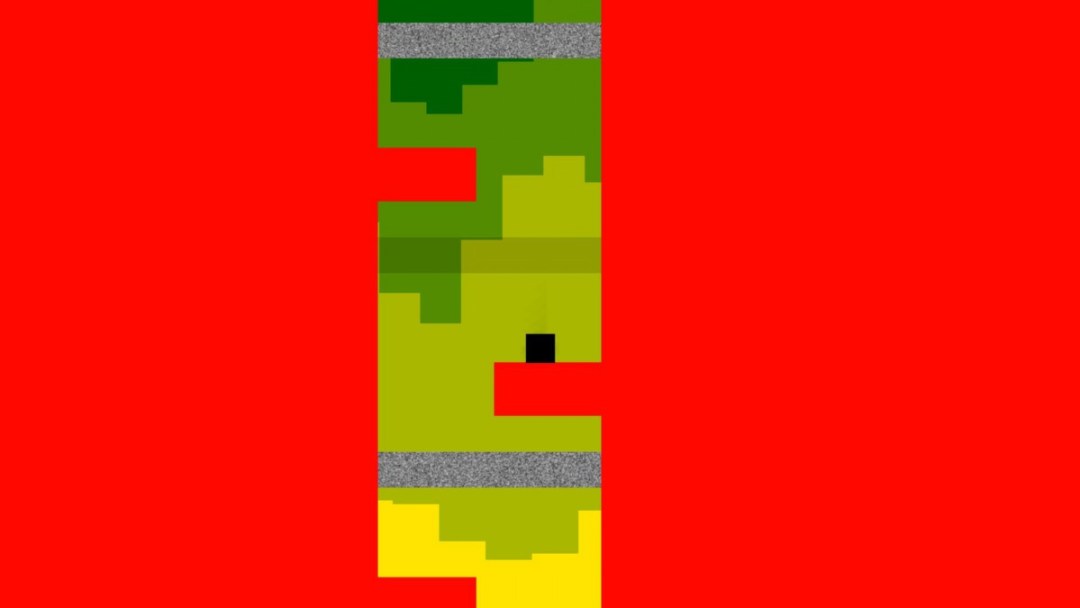
My initial impression of 140 was that it looked like something that might’ve come out in the 70s. Whilst I’m a fan of retro gaming, even I’m too young to properly appreciate the era of the original Atari and games made from simple blocks of colour. That ignorance nearly made me miss out on what is generally an incredibly enjoyable platforming experience though, with 140’s style working perfectly with its twitch gameplay.
140 challenges the player to take a shape-shifting block of colour that transforms between a square, circle and triangle to the end of each level. There’s no context, story, or even instructions; you just dive right into the action. Despite this, the simplicity of the game makes everything feel natural almost immediately.

You’ll work through a series of platforming puzzles whilst collecting an assortment of floating circles that are almost always out of immediate reach, each circle allowing you to progress further through the level. Nothing is ever easy though, with platforms that appear and disappear, jump pads that launch your little shape away and plenty of deadly pits. The environmental hazards are synchronised with the beat of the background music though, so as long as you can work to the music you shouldn’t suffer too much…
Part rhythm puzzler, the bumping background music of 140 plays a big role in the gameplay – you have to carefully time everything you do with the game’s music. The electro soundtrack is upbeat, funky and keeps the pulse going, the extra dependence on following the music’s beat allowing you to appreciate the quality of it. It changes up a lot too, so you never get used to listening to one tune. Even the constant failure that comes with missing a beat didn’t nullify my appreciation of the banging tunes, though thankfully there are enough checkpoints along the way that falling out of beat with the music won’t carry too many consequences.
Expect to fail a lot though; even though following the music of 140 isn’t too difficult, actually working your way through the game’s platforming sections gets more and more taxing the further you progress through the game. Everything is fairly straight forward at first, but by the end you’ll be fiercely mashing buttons as you try to make some incredibly difficult jumps in time. The level design is superb, but seriously, it could be so punishing at times.

Despite the difficulty, 140 never starts to feel frustrating. That could be owed to the fairly short running time of the game though, with a skilled player probably able to the beat the game in around an hour – everything is over before you’ve resorted to swearing or throwing any controllers out of your window. Whilst a low running time might be seen as a flaw to some, the low price-point of the game won’t make you feel too bad about it.
Surprisingly, each of the game’s three stages features a tough boss encounter as a finale. They each play out differently, with your little shape-shifting block of colour granted the ability to attack in some shape or form. Take the first boss encounter – it’s a big sphere of static that’s bouncing around to kill you. Fortunately you can shoot at it with a laser blasting from your shape at specific times, though this comes with a consequence since the sphere breaks apart, splitting into smaller balls each time you hit it à la Pang. Destroy them all and you’ll succeed.
To say that 140’s visuals are simple would be a massive understatement – whilst it certainly isn’t devoid of colour or personality, it wouldn’t look out of place on an old Atari system. That doesn’t mean it’s not charming though and there’s something incredibly appealing about the aesthetic design of the game. It’s absolutely full of colour and the simple backdrops just seem to fit in; it’s specifically designed to look this way and it really compliments the gameplay.

When you beat the game you’ll unlock the more challenging mirror mode, though admittedly it isn’t as gratifying as the mirror modes found in other games. Racers and action games like Castlevania: Symphony of the Night offered enough that trekking through a mirrored setting is neat; there just isn’t enough to 140 to make it that alluring. It’s more punishing too, with the mirrored mode lacking any checkpoints – death results in complete failure with the player having to start again from scratch. It really wasn’t for me, but the short length of the game meant that the challenge is possible. Some players may enjoy it, even if I didn’t.

The beauty of 140 is just how well everything flows together, with the game providing a short platforming experience that isn’t a lot to look at but is thoroughly enjoyable to play.
It’s simple yet ingenious; in a gaming generation that likes to show off graphical prowess, 140 proves that sometimes all you need is a bit of colour, banging beats and some great platforming action to entertain.

Developer: Jeppe Carlsen / Abstraction Games
Publisher: Double Fine Productions
Release Date: 01/09/2016
Format(s): Playstation 4 (Reviewed), Xbox One, Nintendo Wii U, Playstation Vita, PC, Mac, Linux





